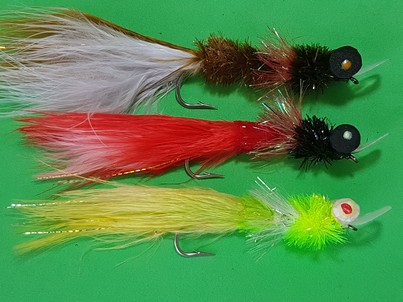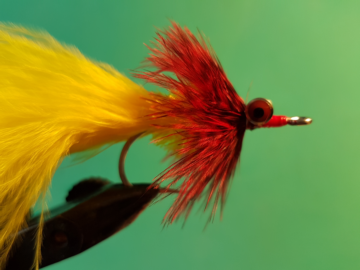Flies
{{start}}
{{end}}

{{+1}}Hackled gold ribbed hares ear{{-1}}
{{start}}
On balance I think it fishes better than the Greenwells Glory. It works equally well on running or still water and is a little more buoyant than the Greenwell Glory and is buoyant enough to support a small bead head nymph in a wet under dry team.{{end}}

{{+1}}Perdigon (Spanish nymph) – gold micro glint{{-1}}
{{start}}
| A streamlined fast sinking fly that will anchor your team. |
Materials
| Hook | Head | Extra weight (optional) | Thread | Tail | Body | Thorax | Coating |
|---|---|---|---|---|---|---|---|
| Hanak 300BL #14 / #16 | 3.0mm / 2.5mm slotted faceted gold tungsten bead | 0.010 lead wire | Fl fire orange UTC UV thread | Coq de Leon Fibres | Brown Micro Glint | Black nail polish | UV Resin and then Varnish. |
Process
| A |
Adding extra weight to the fly.On this fly my preference is to keep the bead size down a little and to add extra weight to compensate for that. |

|
|---|
| B |
|

|
|---|
| C |
|
|
|---|
| D |
|

|
|---|
| E |
|

|
|---|
| F |
|

|
|---|
{{end}}
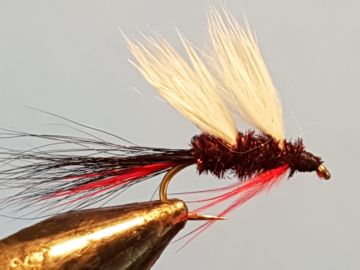
{{+1}}Claret caddis{{-1}}
{{start}}
Any time there are caddis on the wing this fly is worth a swim in the middle position of a team of three loch flies. One of the most important things to remember when tying this fly is not to overdress it ... make sure you can see a gap between the two wings even when the rabbit fur is dry and fluffed out.{{end}}
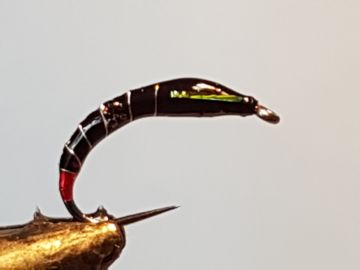
{{+1}}Epoxy midge – black with hot butt & UV cheeks{{-1}}
{{start}}
When Chironomids are around they tend to be around in large numbers and trout become quickly switched on and gorge on them. There are number of techniques to target chironomid feeders and one of my favourite is to fish three chironomid imitations with the heaviest on the point with a long leader on a floating line and fish relatively static. You will be surprised how many fish find your flies.{{end}}
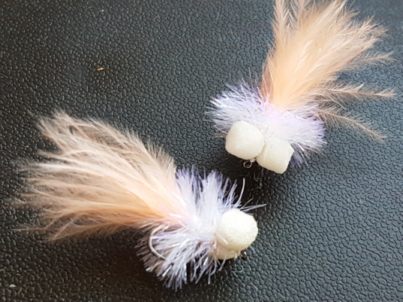
{{+1}}Booby blob{{-1}}
{{start}}
Both boobies and blobs are each tremendous search flies in their own right particularly for stocked rainbow trout. This fly presents the best of both of those worlds and has the head an tail of a booby and the body of a blob. With a little flash in the tail it's one screamer of an attractor pattern.{{end}}
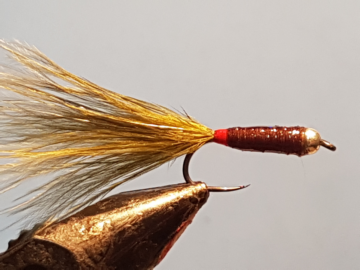
{{+1}}Olive epoxy bugger -silver TBH, UV spine & orange butt{{-1}}
{{start}}
Because of the lack of body dressing and the epoxy body this fly sinks quickly and the mirage tinsel spine that I have added flashes, in a way I am confident will be enticing, to stocked rainbows in particular, as the fly is being worked back to the boat or shore are very enticing.{{end}}
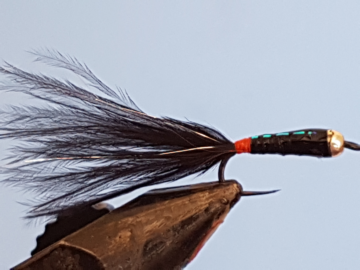
{{+1}}Black epoxy bugger – silver TBH, UV spine & red butt{{-1}}
{{start}}
This fly is my take on one of the flies that was promoted by our 2018 Northern Ireland Commonwealth Fly Fishing Championships team guild as being a productive fly for use in the lakes that we fished there. Because of the lack of body dressing and the epoxy body this fly sinks quickly and apparently is great option for stocked rainbows in particular.{{end}}















